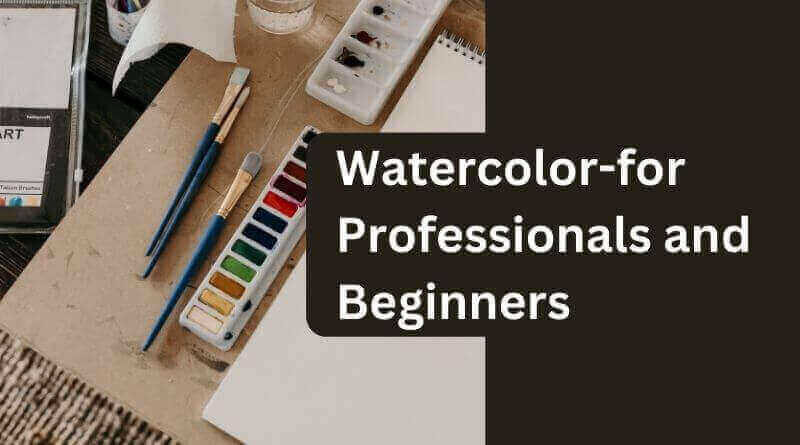Watercolor for Beginners and Professionals
The oldest form of painting, if not the oldest form of art itself, is watercolor painting. East Asians use “brush painting” or “scroll painting” to describe watercolor paintings with inks. The predominant medium in Chinese, Korean, and Japanese paintings have been inkstick or other pigments, frequently used in monochrome blacks or browns. Other nations with a lengthy history of watercolor painting include Ethiopia, India, and others. Especially in the early 19th century, many Western artists predominantly employed watercolor as a sketching medium to prepare the “final” work in oil or engraving. The term “colored sketches” was used to describe classic watercolors until the end of the eighteenth century.
Table of Contents
Components of watercolor panting
Watercolor paint is made up of four main components: a pigment, gum arabic, ox gall, honey, and preservatives as additives to change the viscosity, hiding, durability, or color of the pigment and vehicle mixture, as well as evaporating water as a solvent to thin or dilute the paint before applying it.
Any painting medium applied with a brush, pen, or sprayer that uses water as a solvent is referred to as water media in a more generic sense. This includes the majority of inks, watercolors, tempera, casein, gouaches, and contemporary acrylic paints.
When a complex carbohydrate is used as a binder in paint, it is referred to as a “watercolor.” The preferred binder for watercolors since the 19th century is natural gum arabic, with glycerin and/or honey as additives to improve the binder’s plasticity and solubility and with other chemicals added to improve product shelf life. Originally (in the 16th to 18th centuries), watercolor binders were sugars and/or hide glues.
In contrast to transparent paint, opaque paint is called “body color.” Usually, it’s speaking of gouache, an opaque type of watercolor. A dispersion of acrylic resin serves as the binder in contemporary acrylic paints.
How to choose the best watercolor palettes?
AMOUNT OF COLORS
The beautiful thing about watercolor paint is that you can mix colors to dramatically expand your color palette without buying many different hues. Therefore, you should start with 5 to 10 colors to test them out before making a larger expenditure if you’re considering upgrading to artist-quality paint.
Of course, colors made of a single pigment will be brighter than those made of multiple pigments, but some painters swear by starting with a small selection of single colors and expanding from there. This will largely depend on your preferences and the goals you are pursuing.
PERMANENCE LEVEL
The permanence of paint is its resistance to exposure to light and dampness. This is largely based on the caliber of the pigments and whether any filler is included in the paint to reduce costs. The term permanence is also used to refer to lightfastness. You should check your label to see how each color performs on the ASTM (American Society for Testing and Materials) rating scale. You’re searching for an I (excellent) or II (good) in this category, and most brands, including Winsor & Newton, will also offer this information online.
TRANSPARENT VS. OPAQUE WATERCOLORS
The ability of watercolor paint to let light pass through it and produce a washed-out effect is part of what makes it beautiful. It is common for manufacturers to indicate whether watercolor paint is opaque or transparent on the tubes or pans. Even though opaque watercolors can be thinned out, it’s crucial to know the transparency to get the layered look in most watercolor paintings.
PANS OR TUBES
Small tubes or trays of solid paint, known as pans, are the two most popular ways to purchase watercolors. Pans are fantastic for mobility because they only turn on when a wet brush is applied to the surface. Large-scale projects are a little more challenging to paint since you can only take so much color at once, but each pan will cover a lot of ground.
In contrast, liquid paint is used in tubes. This makes it a little messier to transport but simpler to mix and paint in greater quantities. With tubes, though, it’s simpler to use more paint rapidly, which could result in more frequent paint purchases.
BEST WATERCOLOR SETS FOR BEGINNERS
PRANG’S SET OF 8 WATERCOLORS- For beginning artists who want to experiment without hassle, Prang’s collection of 8 watercolors is a fantastically affordable solution. The oval half-pans are packaged in a sturdy plastic case that is great for transportation. A single brush is included with each transparent, semi-moist color option.
COTMAN SET OF WATERCOLORS- The popular watercolor brand Winsor & Newton’s Cotman range is intended for students. Cotman is a fantastic alternative to Winsor & Newton because artificial fillers keep the costs down while maintaining the high quality of the product. Both pans and tubes are available in the Cotman line; however, because of how portable it is, we prefer the sketchers pocket box. With 12 half-pans, a brush, and a lid that serves as a mixing palette, you have just enough supplies to paint while you’re on the road.
RAPHAEL AQUARELLE WATERCOLOR- Painting anywhere and at any time is made simple for artists by the Raphael Aquarelle Watercolor Travel Set. It has a small, circular container with 10 half-pans of colors appropriate for students, a 12-compartment mixing palette on the top lid, and a small brush. You’ll receive all the colors you need to get started, ranging from Yellow Ochre to Burnt Sienna. Artists can use this pocket-sized kit to paint outside like the Impressionists by stowing it in their luggage.
SARGENT WATERCOLORS- This beginner’s set by Sargent is a good, reasonably priced alternative if you are beginning to paint with watercolors and want to learn more about color theory and mixing. To help you become familiar with color mixing, it comes with 12 tubes of watercolor paint.
VAN GOGH WATERCOLOR- Reviewers gush over the quality of the Van Gogh watercolor tubes, despite them being marketed as student-grade paints. It makes sense, given that the reputable Royal Talens company produces them. They merge smoothly and are compatible with all watercolor styles. The colors are still vibrant after drying, and they dry rapidly. These watercolors can also be purchased as pans and packaged in a handy wood or plastic carrying case for portability.
KURETAKE’S GANSAI WATERCOLOR- The 14 creamy colors of Kuretake’s Gansai collection are made in Japan. According to the traditional Japanese style, each of these paints is expertly made and has a better opacity than watercolors from Europe and the United States. This is made possible by Kuretake’s employment of an alternative binder to the conventional gum arabic found in Western paints. The tough plastic container also has an inner lid for mixing paints.
DANIEL SMITH WATERCOLOR- An American brand of watercolor paint called Daniel Smith is renowned for its artist-grade paints. As it enables you to combine a variety of hues before investing in more tubes, their 6-tube basic watercolor kit is an excellent starting set if you’re hoping to move up to professional watercolor paints. The set includes three warm and cool primary colors from Daniel Smith’s palette of 240+ colors.
SENNELIER’S WATERCOLOR- The student package from Sennelier, renowned for its premium paints, is the ideal travel companion. It includes a mixing tray, an elastic strap, and 24 half-pans for field painting. Clear and vibrant colors are a sign of good transparency, which makes it simple to produce a glazing appearance.
BEST WATERCOLOR SETS FOR PROFESSIONALS
HOLBEIN WATERCOLORS- A smooth, non-granular texture is left behind by Japanese-made Holbein watercolors, which advertise that they are “more finely ground than any other artist watercolor.” Reviewers claim they offer various vivid and vibrant colors and don’t typically dry out in the tube.
GRUMBACHER WATERCOLORS- The brand Grumbacher is favored by seasoned watercolorists. With the help of the 12 color wells in the plastic box, these 12 tubes come in, and you may mix the paint to make even more hues. A camel-hair watercolor paintbrush is also included so you can start painting immediately.
MIJELLO’S MISSION GOLD- The colors of nature-inspired Mijello’s Mission Gold Watercolors were created with the assistance of skilled watercolorists. This 24-piece set includes a variety of vibrant, 7 ml tubes with excellent lightfastness.
M.GRAHAM’S WATERCOLOR- For artists who prefer a thicker consistency to their paint, M.Graham’s use of honey as an addition makes it an excellent choice. This professional watercolor paint, which has a high pigment load, is well-known for being inexpensive.
WINSOR & NEWTON’S PROFESSIONAL- Winsor & Newton’s professional drawing case is a great choice if you prefer using tubes and want something portable. Winsor & Newton professional watercolor paints, renowned for having a high pigment content, are included in 12 tubes. Winsor & Newton is more expensive than other brands, yet it continues to enjoy popularity for its all-around high quality and seamless consistency.
SENNELIER WATERCOLOR- One of the most popular professional brands is Sennelier, which employs honey as an ingredient to facilitate rewetting. Since Sennelier also offers pans separately, you may refill or add new colors as needed with this portable set. It is very simple to transport. “They respond quite rapidly to a wet brush, quicker than some other pan paints I’ve used,” one reviewer writes. Rich, vivid, and highly pigmented colors are used.
DALER-ROWNEY AQUAFINE WATERCOLOR SET- There are 24 hues in the Daler-Rowney Aquafine Watercolor Set, making it simple to mix them and apply subtle washes. The kit is fantastic for professionals and students because of its affordable price and high-quality pigments.
SCHMICKE WATERCOLOR- Schmincke has been utilizing the same, time-tested recipe since 1881 and is renowned for its exceptional quality. The German company offers a range of 139 hues, with 112 having the greatest lightfastness. One reviewer refers to them as “Winsor & Newton on steroids!” and claims that “the colors portray a delicate softness that I think is similar to WN watercolors, but Schmincke has a bit more boldness and flow more variance in opaque and translucent colors, and much more granulation in certain colors.” They also offer the student-grade Akademie Aquarell range if you like pans.
UTRECHT WATERCOLOR- For experienced artists wishing to indulge themselves, this gorgeous set from Utrecht is well worth the cost. It includes a Yasutomo fan-shaped plastic palette with 24 different wells, an artist sponge, a kneaded eraser in addition to 18 tubes of professional watercolors, four Utrecht brushes, and one Utrecht flat knife. It comes in a stylish Beechwood wood case that will make you want to walk outside and set up your easel instantly.
REMBRANDT WATERCOLOR- Rembrandt professional watercolors, produced by the same company as Van Gogh’s, are renowned for their transparent color and silky texture. Their 24-pan set is the ideal watercolor kit for the professional watercolorist if you want to work in layers and want to splash out on various colors.
LUKAS WATERCOLORS- This lavish collection of 70 colors by Lukas is designed for experienced painters who need access to the entire color spectrum. To make traveling simple, each of these premium half-pan shades is neatly packaged inside a wooden box.
ARE TUBE OR PAN WATERCOLORS GOOD TO USE?
Both tube or pan watercolors have advantages and disadvantages.
Pans are fantastic for mobility because they only turn on when a wet brush is applied to the surface. Large-scale projects are a little more challenging to paint since you can only take so much color at once, but each pan will cover a lot of ground. In contrast, liquid paint is used in tubes. This makes it a little messier to transport but simpler to mix and paint in greater quantities. With tubes, though, it’s simpler to use more paint rapidly, which could result in more frequent paint purchases. Additionally, because many brands of paint don’t hold up well to frequent rewetting, artists must be careful not to allow the paint to dry out.
Recommended Articles:




